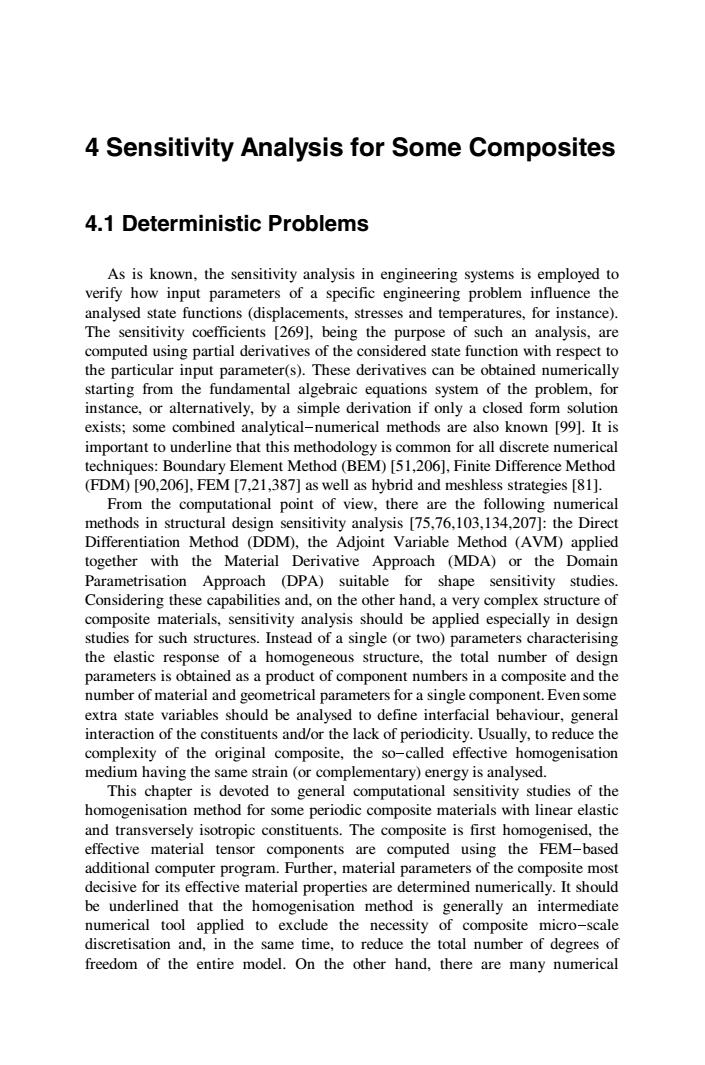正在加载图片...

4 Sensitivity Analysis for Some Composites 4.1 Deterministic Problems As is known,the sensitivity analysis in engineering systems is employed to verify how input parameters of a specific engineering problem influence the analysed state functions (displacements,stresses and temperatures,for instance). The sensitivity coefficients [269],being the purpose of such an analysis,are computed using partial derivatives of the considered state function with respect to the particular input parameter(s).These derivatives can be obtained numerically starting from the fundamental algebraic equations system of the problem,for instance,or alternatively,by a simple derivation if only a closed form solution exists;some combined analytical-numerical methods are also known [99].It is important to underline that this methodology is common for all discrete numerical techniques:Boundary Element Method (BEM)[51,206],Finite Difference Method (FDM)[90,206],FEM [7,21,387]as well as hybrid and meshless strategies [81] From the computational point of view,there are the following numerical methods in structural design sensitivity analysis [75,76,103,134,207]:the Direct Differentiation Method (DDM),the Adjoint Variable Method (AVM)applied together with the Material Derivative Approach (MDA)or the Domain Parametrisation Approach (DPA)suitable for shape sensitivity studies. Considering these capabilities and,on the other hand,a very complex structure of composite materials,sensitivity analysis should be applied especially in design studies for such structures.Instead of a single (or two)parameters characterising the elastic response of a homogeneous structure,the total number of design parameters is obtained as a product of component numbers in a composite and the number of material and geometrical parameters for a single component.Even some extra state variables should be analysed to define interfacial behaviour,general interaction of the constituents and/or the lack of periodicity.Usually,to reduce the complexity of the original composite,the so-called effective homogenisation medium having the same strain (or complementary)energy is analysed. This chapter is devoted to general computational sensitivity studies of the homogenisation method for some periodic composite materials with linear elastic and transversely isotropic constituents.The composite is first homogenised,the effective material tensor components are computed using the FEM-based additional computer program.Further,material parameters of the composite most decisive for its effective material properties are determined numerically.It should be underlined that the homogenisation method is generally an intermediate numerical tool applied to exclude the necessity of composite micro-scale discretisation and,in the same time,to reduce the total number of degrees of freedom of the entire model.On the other hand,there are many numerical4 Sensitivity Analysis for Some Composites 4.1 Deterministic Problems As is known, the sensitivity analysis in engineering systems is employed to verify how input parameters of a specific engineering problem influence the analysed state functions (displacements, stresses and temperatures, for instance). The sensitivity coefficients [269], being the purpose of such an analysis, are computed using partial derivatives of the considered state function with respect to the particular input parameter(s). These derivatives can be obtained numerically starting from the fundamental algebraic equations system of the problem, for instance, or alternatively, by a simple derivation if only a closed form solution exists; some combined analytical-numerical methods are also known [99]. It is important to underline that this methodology is common for all discrete numerical techniques: Boundary Element Method (BEM) [51,206], Finite Difference Method (FDM) [90,206], FEM [7,21,387] as well as hybrid and meshless strategies [81]. From the computational point of view, there are the following numerical methods in structural design sensitivity analysis [75,76,103,134,207]: the Direct Differentiation Method (DDM), the Adjoint Variable Method (AVM) applied together with the Material Derivative Approach (MDA) or the Domain Parametrisation Approach (DPA) suitable for shape sensitivity studies. Considering these capabilities and, on the other hand, a very complex structure of composite materials, sensitivity analysis should be applied especially in design studies for such structures. Instead of a single (or two) parameters characterising the elastic response of a homogeneous structure, the total number of design parameters is obtained as a product of component numbers in a composite and the number of material and geometrical parameters for a single component. Even some extra state variables should be analysed to define interfacial behaviour, general interaction of the constituents and/or the lack of periodicity. Usually, to reduce the complexity of the original composite, the so-called effective homogenisation medium having the same strain (or complementary) energy is analysed. This chapter is devoted to general computational sensitivity studies of the homogenisation method for some periodic composite materials with linear elastic and transversely isotropic constituents. The composite is first homogenised, the effective material tensor components are computed using the FEM-based additional computer program. Further, material parameters of the composite most decisive for its effective material properties are determined numerically. It should be underlined that the homogenisation method is generally an intermediate numerical tool applied to exclude the necessity of composite micro-scale discretisation and, in the same time, to reduce the total number of degrees of freedom of the entire model. On the other hand, there are many numerical